Machine Learning for the Improvement of Deep Renovation Building Projects Using As-Built BIM Models
Abstract
1. Introduction
1.1. Background
1.2. Overview of AI Applications for the Built Environment
1.3. Contributions and Work Structure
2. Key Elements for the Proposed ML-Based Diagnosis-Support Solutions
2.1. Classification Methods Overview of ML in Deep Renovation Projects
2.1.1. Rule-Based Classification
2.1.2. Expert System
2.1.3. Decision Trees
- The internal nodes, which are non-leaf nodes that denote a test on an attribute;
- The branches, which represent the outcomes of a test;
- The leaf nodes, which are terminal nodes that hold a class label;
- The root node, which is the topmost node in the tree.
Attribute Selection
- Information Gain. It is based on the work of Shannon and Weaver [30] on information theory, which studied the value of “information content” of messages. The highest gain attribute is the splitting gain attribute for the node, and it minimizes the information needed to classify the tuples in the resulting partitions, in order to be the least impure as possible. The information needed to classify a tuple in A (2):where is the nonzero probability that an arbitrary tuple in D belongs to class and it is estimated by . Info is also known as the entropy of D. Info gain is defined as the difference between the original information requirement and the new one. It indicates how much would be gained by branching on A (3).
- Gain ratio. It is defined in the following way (4):where the splitting attribute selected will be the one with the maximum gain ratio. It must be taken into account that as the divided information approaches 0, the ratio becomes unstable.
- Gini index. It measures the impurity of D, a data partition or set of training tuples as (5):where is the probability that an arbitrary tuple in D belongs to class and is estimated by . The sum is computed over m classes. Each attribute is split in a binary way. In this situation, a weighted sum of the impurity of each resulted partition is computed, as it can be seen in the following example (6).For a discrete-valued attribute, the subset that provides the minimum Gini index for the considered attributed is selected as the splitting subset. In case of continuous-value attributes, it is common to establish the set point in the middle of the interval values.
2.2. Building Pathologies Databases
Existing Pathology Databases
- Technische ABC-lijst by Woningborg (The Netherlands) [33]. This database mainly contains attention points and recommendations for building designers and building constructors, but not many typical pathologies are described. The searching tool allows to look for information by a set of predefined fields (construction products, regulatory aspects, design features). A license is required to create a user account.
- Danish Building Defects Fund by Byggeskadefonde (Denmark) [34]. This website belongs to a privately owned institution established in 1986, same year of the law on public housing in that country. The Fund comprises publicly subsidised housing and also publicly subsidised renovations. The database offers information from 1 to 5 year inspections carried out since 1997 (in Danish), and no login is required. Among the aspects included in the inspection, the following building elements can be mentioned: Excavation foundations and basement, structural and stabilizing elements, exterior walls, roof constructions, wet room, floor and building drainage, water, heat and ventilation, concrete in an aggressive environment and other elements. The search engine allows to search by type of building, but not by technical aspect, which impedes the query for our purpose.
- Schadis—Die Datenbank zu Bauschäden by Fraunhofer Institut IRB (Germany) [35]. This site, offered by Fraunhofer-Informationszentrum Raum und Bau IRB, represents the largest collection in the field of building pathologies in German. It contains information from over 700 books, articles and reports, and can be accessed online under license.
- The Building Pathology Study Group by PATORREB (Portugal) [36]. This website provides a pathology catalogue compiled by a set of Portuguese universities. Pathologies can be consulted by location (roof, external wall, basement wall, etc.), and for each of them, a set of typical problems are listed and described. An account is required, otherwise, only an example can be accessed.
- Agence Qualité Construction by REX BBC (France) [37]. This agency has developed a database that comprises several pathology reports called SYCODÈS (SYstème de COllecte des DÉSordres). This website, produced by the AQC and funded by the PRACTE program, the ADEME and the AQC, provides technical resources for trainers and players in high performance construction and renovation. Information is organized in several areas such as opaque walls, glass walls, heating and cooling, Domestic Hot Water (DHW), ventilation, lighting and specific electricity, steering, electricity production, organizational aspects and regulations. Each area contains short articles of good practice examples and links to reports, guides, technical information and reference texts.
2.3. TABULA Solutions Catalogue
3. Diagnosis and Optimisation Algorithm Using ML
3.1. Data Acquisition
3.2. Design of the Algorithm
3.2.1. Definition of Building Pathologies According to the Algorithm Design
3.2.2. Decision Logic Implemented by the Proposed Algorithm
- If the global heat transfer coefficient of the whole building envelope exceeds the given limit, the heat transfer coefficient of the windows is checked. The first correction would be to use a new window element, with a heat transmission coefficient according to the respective regulation. If the problem remains unsolved, a new iteration is performed, reducing the U-value of the window by 10%. Again, if the desired limit is still not reached, a second iteration is carried out, now considering a much bigger improvement that will be explained later in the solutions catalogue. This second iteration is conditioned by real market solutions, where it can be verified that there is a significant jump in the value of the heat transmission coefficient of the windows depending on whether they incorporate double or triple glazing.
- If the window renovation is not sufficient to address the problem and an intervention on the wall is possible, the algorithm continues to check the U-values of the walls. The process at this level is quite similar to the previously mentioned problem existing for windows, but in this case, it is almost impossible to transform the U-values of the walls exactly to the limit value. Therefore, at this stage, two possible measures are given for each kind of intervention. If all the solutions are applicable, the validation sequence would be to insert insulation at the wall cavity, or the outer or internal layer.
- It is possible to select only one solution of this type, two or the three of them, always maintaining the prioritization sequence. As mentioned above, there may be a number of reasons to avoid considering any of them.
- Cavity insulation: The algorithm first checks the presence of an air cavity and its thickness (has to be between 40 and 100 mm in order to consider it viable). In case it exists, first iteration would consider filling the entire cavity with a material with certain conductivity characteristics available in the market. A second iteration would be carried out if the desired levels are not achieved, this time considering a second material with a lower thermal conductivity.
- Insulation on the external layer: the algorithm proposes an intervention with a specific material, with specific thickness and thermal conductivity characteristics according to the market options and the typical thickness values used in the country. If the desired limits are still not reached, a second iteration includes an improved performing solution, changing the used material, this time selecting one with a lower thermal conductivity. Again, if there is still not a solution, the algorithm iterates once again, this time changing the thickness of the material: The same materials considered before are included in the third and fourth iterations.
- Insulation on the internal layer: The approach is the same as that followed for the insulation on the external layer.
- If there is still no solution, the algorithm iterates once again, this time changing the thickness of the material: The same materials considered before are included in the third and fourth iterations.
- If the insulation of the wall is not enough to address the problem, and an intervention on the roof is possible, the algorithm continues to check the U-values of the roof. The process at this level is quite similar to the one for walls. The algorithm first checks if the building has a flat or sloped roof, whereby two different paths are drawn depending on this feature.
- Pitched roof: In case there is a slope, the first proposed intervention is to place insulation on the internal side of the roof (this requires access under the roof). A second iteration proposes an external measure: As explained above, it can be considered more intrusive although it is performed at the external side of the building.
- Flat roof: In case the roof is flat, only external measures are proposed, taking into account a specific material, with specific thickness and conductivity characteristics according to market options and the typical thickness used in the country. The second iteration, again offers an improvement in thermal performance.
- The algorithm has been defined so that it is not possible to continue with roof renovation without renovating the wall before.
3.2.3. Solutions Catalogue Definition
- SPAIN: In this context, the solutions provided for walls include the possibility of adding insulation to the interior surface of the building, on the exterior surface (through External Thermal Insulation Composite System, ETICS), as well as the cavity inside the wall. ETICS is an easy technology in which all the works are made on site and is widely used in the European market [51]. Thanks to its application on the outside of the building is a solution that protects the structure of the building by protecting its exterior walls from atmospheric agents, and provides high indoor thermal comfort both in summer and winter, as has been proven in some studies such as [52]. In this solution different materials can be applied as thermal insulation, EPS (expanded polystyrene) being the most used material in Europe [51]. Generally, EPS has a good performance but the drawback is that it has poor fire performance (E fire class). Due to this poor fire properties, it is recommended to use it on the buildings until 25 m above the ground. Moreover, the solution with ETICS is relatively light and no reinforcing is needed. Considering this information, and the material thicknesses available on the market, the range values for them have been defined as shown in Table 5. Roofing solutions for roofs are also determined by these thickness limits.
- FRANCE: No detailed information has been found in TABULA due to incomplete fields in the web site. That is why the same approach followed for Spain has been considered.
- GERMANY: The solutions listed in TABULA include the possibility of adding insulation on the interior or exterior surface of the building. However, cavity wall insulation is also considered since the algorithm checks in advance if there is enough available space. As in the case of Spain, the solution of applying ETICS as external insulation is widely used in Germany since 1960s [53]. The thicknesses of the materials for the insulation on the exterior surface are different from those considered in Spain. They have been adapted to the solutions available in the market (the same for the roof insulation). Table 6 depicts this information.
- POLAND: According to TABULA solutions, it is not clear if it is typical to apply the three types of measures considered for walls (not indicated). However, the most common renovation technique used in Poland consists of adding insulation on the external walls with ETICS using EPS as thermal insulation and an average thickness of 15–20 cm [51]. Insulating buildings from inside is not very common, it is used mainly on the buildings that are under cultural heritage protection. When it comes to the cavity, the number of buildings where it can be applied is rather low. Therefore, all three have been included, and material thicknesses have been adapted to the range values included here, both for walls and roofs. Detailed values are included in Table 7. Solutions for windows have also been explored. However, they are easier to characterize, since, depending on different configurations, expected U-values can be achieved. They are also accompanied by an economic estimate.
4. Results
4.1. First Model: Medium Quality Building Prototype
4.2. Second Model: Low Quality Building Prototype
4.3. Third Model: Low Quality Building Prototype with Flat Roof
5. Discussion and Conclusions
Author Contributions
Funding
Institutional Review Board Statement
Informed Consent Statement
Data Availability Statement
Conflicts of Interest
Abbreviations
| AEC | Architectural, Engineering and Construction |
| AI | Artificial Intelligence |
| As-Built | Drawings, models and documentation of the building as-constructed, including all deviations that have appeared in the construction phase |
| BIM | Building Information Modeling |
| CAD | Computer-Aided Design |
| CIB | International Council for Research and Innovation in Building and Construction |
| DHW | Domestic Hot Water |
| DR | Deep Renovation |
| ECM | Energy Conservation Measure |
| EED | Energy Efficiency Directive |
| ETICS | External Thermal Insulation Composite System |
| EPS | Expanded polystyrene |
| EPBD | Energy Performance of Buildings Directive |
| GHG | Greenhouses Gases |
| GUI | Graphical User Interface |
| IFC | Industry Foundation Classes |
| KBS | Knowledge Based System |
| MDPI | Multidisciplinary Digital Publishing Institute |
| ML | Machine Learning |
| NZEBs | Nearly Zero-Energy Buildings |
| OWL | Web Ontology Language |
| SPARQL | SPARQL Protocol and RDF Query Language |
References
- The European Commission. Commission Recommendation (EU) 2019/786 of 8 May 2019 on Building Renovation; Technical Report; The European Commission: Brussels, Belgium, 2019; Available online: https://eur-lex.europa.eu/legal-content/GA/TXT/?uri=CELEX:32019H0786 (accessed on 7 March 2021).
- United Nations Environment Programme. 2020 Global Status Report For Buildings and Construction: Towards a Zero-Emissions, Efficient and Resilient Buildings and Construction Sector; Technical Report; Global Alliance for Buildings and Construction: Nairobi, Kenya, 2020; Available online: http://www.un.org/Depts/ (accessed on 23 March 2021).
- The European Commission. Directive (EU) 2018/844 of 30 May 2018; Technical Report; The European Commission: Brussels, Belgium, 2018; Available online: https://eur-lex.europa.eu/legal-content/en/TXT/?uri=CELEX%3A32018L0844 (accessed on 8 March 2021).
- International Organization for Standarization (ISO). ISO 16739-1:2018—Industry Foundation Classes (IFC) for Data Sharing in the Construction and Facility Management Industries; ISO: Geneva, Switzerland, 2018; Available online: https://www.iso.org/standard/70303.html (accessed on 14 March 2021).
- Dimitrov, A.; Golparvar-Fard, M. Vision-based material recognition for automated monitoring of construction progress and generating building information modeling from unordered site image collections. Adv. Eng. Inform. 2014, 28, 37–49. [Google Scholar] [CrossRef]
- Wu, X.; Liu, X. Building crack identification and total quality management method based on deep learning. Pattern Recognit. Lett. 2021, 145, 225–231. [Google Scholar] [CrossRef]
- Shirowzhan, S.; Sepasgozar, S.M.; Li, H.; Trinder, J.; Tang, P. Comparative analysis of machine learning and point-based algorithms for detecting 3D changes in buildings over time using bi-temporal lidar data. Autom. Constr. 2019, 105, 102841. [Google Scholar] [CrossRef]
- Lamio, F.; Farinha, R.; Laasonen, M.; Huttunen, H. Classification of Building Information Model (BIM) Structures with Deep Learning. In Proceedings of the 2018 7th European Workshop on Visual Information Processing (EUVIP), Tampere, Finland, 26–28 November 2018; Institute of Electrical and Electronics Engineers Inc.: Piscataway, NJ, USA, 2019. [Google Scholar] [CrossRef]
- Ryu, M.; Truong, H.L.; Kannala, M. Understanding quality of analytics trade-offs in an end-to-end machine learning-based classification system for building information modeling. J. Big Data 2021, 8, 31. [Google Scholar] [CrossRef]
- Van Balen, K. Expert system for evaluation of deterioration of ancient brick masonry structures. Sci. Total Environ. 1996, 189–190, 247–254. [Google Scholar] [CrossRef]
- Moodi, F.; Knapton, J. Research into a Management System for Diagnosis, Maintenance, and Repair of Concrete Structures. J. Constr. Eng. Manag. 2003, 129, 555–561. [Google Scholar] [CrossRef]
- Bernat, E.; Gil, L. Aided Diagnosis of Structural Pathologies with an Expert System. Adv. Struct. Eng. 2013, 16, 379–393. [Google Scholar] [CrossRef]
- de Brito, J.; Pereira, C.; Silvestre, J.D.; Flores-Colen, I. Expert Knowledge-Based Inspection Systems; Springer International Publishing: Cham, Switzerland, 2020. [Google Scholar] [CrossRef]
- de Freitas, V.P. A State-of-the-Art Report on Building Pathology; CIB W086—Building Pathology Commission: Porto, Portugal, 2013. [Google Scholar]
- Lee, D.Y.; Chi, H.L.; Wang, J.; Wang, X.; Park, C.S. A linked data system framework for sharing construction defect information using ontologies and BIM environments. Autom. Constr. 2016, 68, 102–113. [Google Scholar] [CrossRef]
- Koo, B.; Shin, B.; Krijnen, T.F. Employing outlier and novelty detection for checking the integrity of BIM to IFC entity associations. In Proceedings of the 34th International Symposium on Automation and Robotics in Construction (ISARC 2017), Taipei, Taiwan, 28 June–1 July 2017; pp. 14–21. [Google Scholar] [CrossRef]
- Koo, B.; Shin, B. Applying novelty detection to identify model element to IFC class misclassifications on architectural and infrastructure Building Information Models. J. Comput. Des. Eng. 2018, 5, 391–400. [Google Scholar] [CrossRef]
- Krijnen, T.; Tamke, M. Assessing Implicit Knowledge in BIM Models with Machine Learning. In Modelling Behaviour; Springer International Publishing: Cham, Switzerland, 2015; pp. 397–406. [Google Scholar] [CrossRef]
- Lee, G.; Won, J.; Ham, S.; Shin, Y. Metrics for Quantifying the Similarities and Differences between IFC Files. J. Comput. Civ. Eng. 2011, 25, 172–181. [Google Scholar] [CrossRef]
- Lilis, G.; Giannakis, G.; Rovas, D. Detection and semi-Automatic correction of geometric inaccuracies in IFC files. In Proceedings of the BS2015: 14th Conference of International Building Performance Simulation Association (IBPSA), Hyderabad, India, 7–9 December 2015; pp. 2182–2189. [Google Scholar]
- Wu, J.; Zhang, J. New Automated BIM Object Classification Method to Support BIM Interoperability. J. Comput. Civ. Eng. 2019, 33, 04019033. [Google Scholar] [CrossRef]
- Eftekharirad, R.; Nik-Bakht, M.; Hammad, A. Extending IFC for fire emergency real-time management using sensors and occupant information. In Proceedings of the 35th International Symposium on Automation and Robotics in Construction (ISARC 2018), Berlin, Germany, 20–25 July 2018; pp. 985–992. [Google Scholar] [CrossRef]
- Gu, J.; Zhang, H.; Gu, M. Automatic Integrity Checking of IFC Models relative to Building Regulations. In Proceedings of the International Conference on Internet Multimedia Computing and Service, Xi’an, China, 19–21 August 2016; Association for Computing Machinery: New York, NY, USA, 2016; pp. 52–56. [Google Scholar] [CrossRef]
- Getuli, V.; Ventura, S.M.; Capone, P.; Ciribini, A.L. BIM-based Code Checking for Construction Health and Safety. Procedia Eng. 2017, 196, 454–461. [Google Scholar] [CrossRef]
- TABULA and EPISCOPE Projects. TABULA WebTool. Available online: https://webtool.building-typology.eu/ (accessed on 7 March 2021).
- Han, J.; Kamber, M.; Pei, J. Data Mining: Concepts and Techniques, 3rd ed.; Morgan Kaufmann, Elsevier: Waltham, MA, USA, 2012. [Google Scholar]
- Van den Beukel, A. Building Pathology: A State-of-the-Art Report; CIB W086—Building Pathology Commission: Rotterdam, The Netherlands, 1993. [Google Scholar]
- Giaratanno, J.; Riley, G.D. Expert Systems: Principles and Programming, 4th ed.; Course Technology Inc.: Boston, MA, USA, 2004. [Google Scholar]
- Tolun, M.R.; Sahin, S.; Oztoprak, K. Expert Systems. In Kirk-Othmer Encyclopedia of Chemical Technology; John Wiley & Sons, Inc.: Hoboken, NJ, USA, 2016; pp. 1–12. [Google Scholar] [CrossRef]
- Shannon, C.E.; Weaver, W. The Mathematical Theory of Communication; University of Illinois Press: Urbana, IL, USA, 1949. [Google Scholar]
- Watt, D.S. Building Pathology: Principles and Practice, 2nd ed.; Blackwell Publishing: Oxford, UK, 2007. [Google Scholar]
- International Organization for Standardization (ISO). ISO 15686-1:2011—Buildings and Constructed Assets—Service Life Planning—Part 1: General Principles and Framework; ISO: Geneva, Switzerland, 2011; Available online: https://www.iso.org/standard/45798.html (accessed on 23 March 2021).
- Woningborg-Groep. Technische ABC-Lijst. Available online: http://www.technische-abc.nl/ (accessed on 22 March 2021).
- Byggeskadefonden. Søg i Database Med Eftersyn. Available online: https://bsf.dk/eftersyn/sog-i-database-med-eftersyn (accessed on 22 March 2021).
- Fraunhofer IRB. SCHADIS—Die Datenbank zu Bauschäden. Available online: https://www.irb.fraunhofer.de/schadis/ (accessed on 22 March 2021).
- The Building Pathology Study Group. PATORREB. Available online: https://patorreb.com/ (accessed on 22 March 2021).
- Agence Qualité Construction (AQC). REXBP. Available online: https://www.dispositif-rexbp.com/des-ressources-classees-parthematique (accessed on 22 March 2021).
- INSITER Consortium. INSITER-D1.1: Best Practices and Existing Shortcomings. Technical Report. 2016. Available online: https://www.insiter-project.eu/en/research-results/d1-1 (accessed on 7 March 2021).
- Qi, Y.; Qian, Q.K.; Meijer, F.M.; Visscher, H.J. Identification of Quality Failures in Building Energy Renovation Projects in Northern China. Sustainability 2019, 11, 4203. [Google Scholar] [CrossRef]
- Qi, Y.; Qian, Q.; Meijer, F.; Visscher, H. Causes of Quality Failures in Building Energy Renovation Projects of Northern China: A Review and Empirical Study. Energies 2020, 13, 2442. [Google Scholar] [CrossRef]
- TABULA Project Partners. IEE Project TABULA. 2012. Available online: https://episcope.eu/iee-project/tabula/ (accessed on 23 March 2021).
- EPISCOPE Project Partners. IEE Project EPISCOPE. 2014. Available online: https://episcope.eu/iee-project/episcope/ (accessed on 23 March 2021).
- BuildingSMART Internacional. Industry Foundation Classes (IFC)—An Introduction. Technical Report. Available online: https://technical.buildingsmart.org/standards/ifc/ (accessed on 7 March 2021).
- Krijnen, T. IfcOpenShell. Available online: http://ifcopenshell.org/ (accessed on 7 March 2021).
- Krijnen, T. IfcOpenShell-Python: A Python Module Based on IfcOpenShell. 2020. Available online: http://ifcopenshell.org/python (accessed on 25 March 2021).
- Ministerio de Fomento. Documento Básico HE Ahorro de Energía; Technical Report; Ministerio de Fomento: Madrid, Spain, 2019. Available online: https://www.codigotecnico.org/pdf/Documentos/HE/DBHE.pdf (accessed on 22 March 2021).
- Bundesministerium für Wirtschaft und Energie. Energieeinsparverordnung vom 24. Juli 2007 (BGBI. I. S. 1519). Verordnung über Energiesparenden Wärmeschutz und Energiesparende Anlagentechnik bei Gebäuden; Technical Report; Bundesministerium für Wirtschaft und Energie: Berlin, Germany, 2016. Available online: https://www.enev-profi.de/wp-content/uploads/EnEV-2014-Lesefassung.pdf (accessed on 22 March 2021).
- Bekierski, D.; Gerylo, R.; Kaczorek, D. EPBD Implementation in Poland. Status in December 2016; Technical Report; Techniki Budowlanej; Przemysław Perczyński, Ministerstwo Infrastruktury i Budownictwa: Warszawa, Poland, 2016. Available online: https://www.buildup.eu/sites/default/files/content/ca-epbd-iv-poland-2018.pdf (accessed on 22 March 2021).
- Journal Officiel de la Republique Francese (JORF). JORF nº0184 du 8 août 2008. Arrêté du 13 Juin 2008 Relatif à la Performance énergétique des bâtiments Existants de Surface Supérieure à 1000 Mètres Carrés, Lorsqu’ils Font l’Objet de Travaux de Rénovation Importants. NOR: DEVU0813714A; Technical Report; Republique Francese: Paris, France, 2008. Available online: https://www.legifrance.gouv.fr/loda/id/JORFTEXT000019308241/ (accessed on 22 March 2021).
- CYPE Ingenieros. Generador de Precios de la Construcción; CYPE Ingenieros: Alicante, Spain, 2018; Available online: http://www.generadordeprecios.info/ (accessed on 30 March 2021).
- Pasker, R. The European Etics Market Facts & Figures; Technical Report; European Association for ETICS (EAE): London, UK, 2015; Available online: https://www.ea-etics.eu/files/dokumente-eae/4_ETICS_Forum/04_2015-10-10_ETICS_Forum_2015_European_ETICS_market_Pasker_02.pdf (accessed on 29 March 2021).
- Varela Luján, S.; Viñas Arrebola, C.; Rodríguez Sánchez, A.; Aguilera Benito, P.; González Cortina, M. Experimental comparative study of the thermal performance of the façade of a building refurbished using ETICS, and quantification of improvements. Sustain. Cities Soc. 2019, 51, 101713. [Google Scholar] [CrossRef]
- Künzel, H.; Künzel, H.M.; Sedlbauer, K. Long-term performance of external thermal insulation systems (ETICS). Acta Sci. Polonorum. Archit. 2006, 5, 11–24. [Google Scholar]
- BIM-SPEED Project Partners. Harmonised Building Information Speedway for Energy-Efficient Renovation (BIM-SPEED Project). 2018. Available online: https://cordis.europa.eu/project/id/820553 (accessed on 25 March 2021).
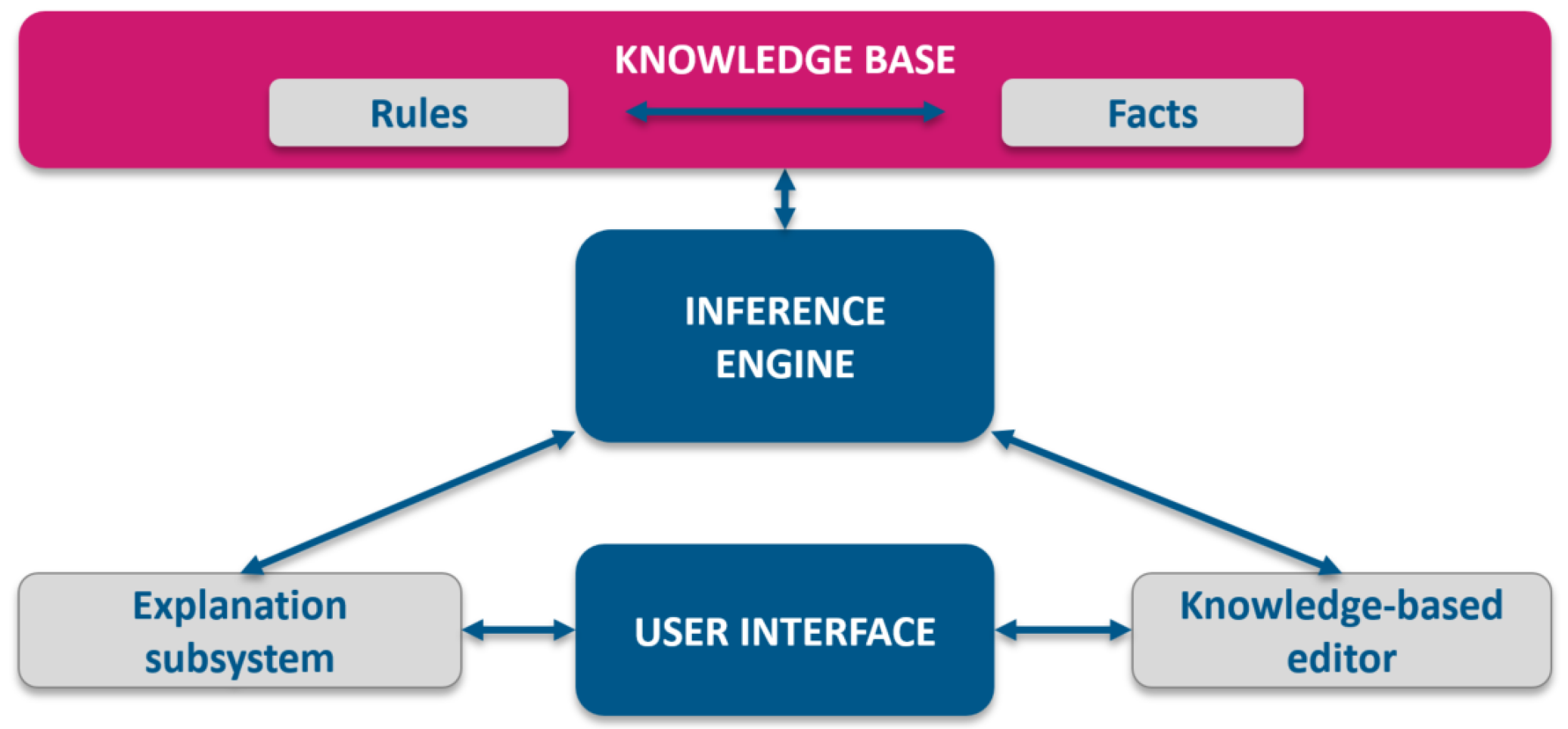

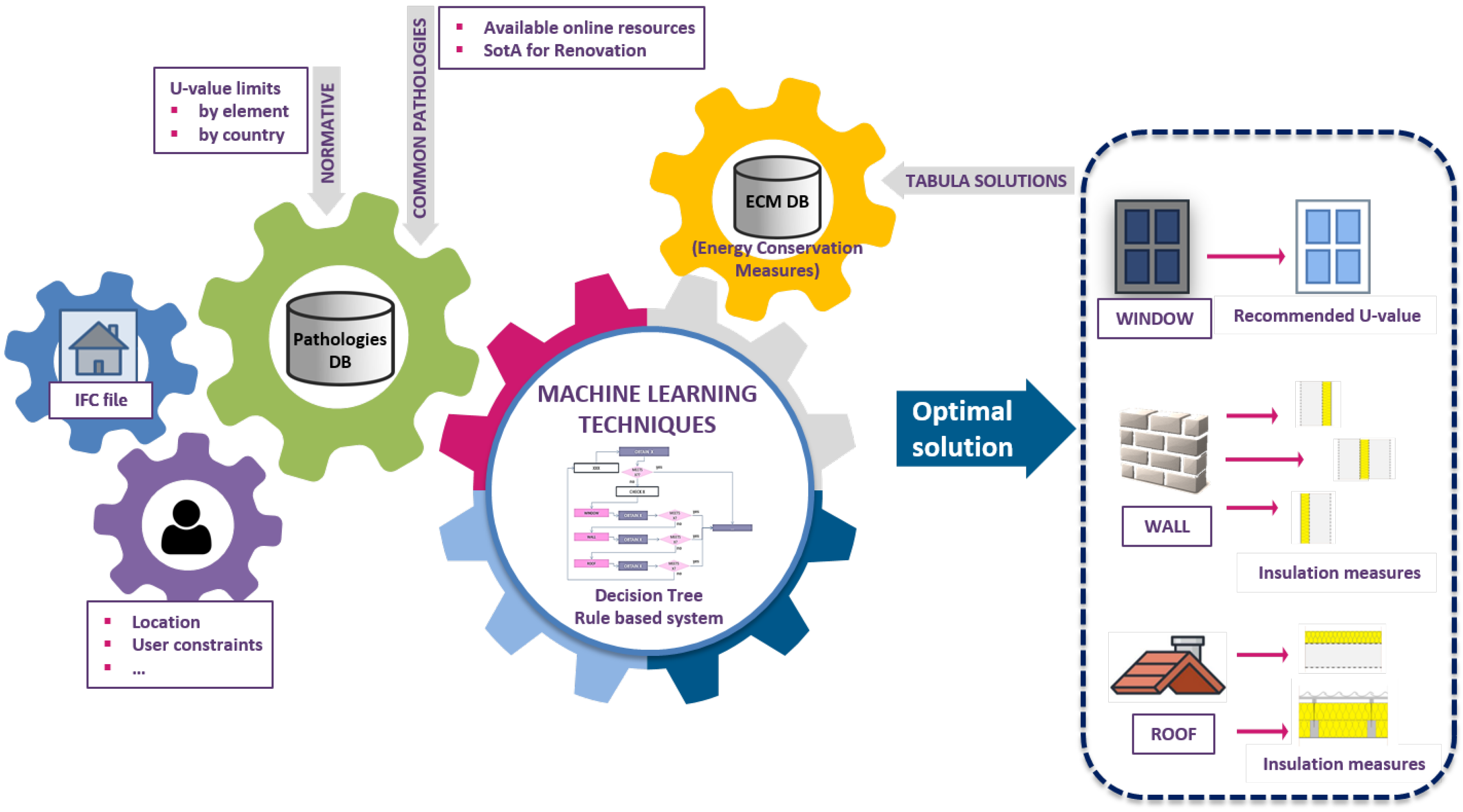
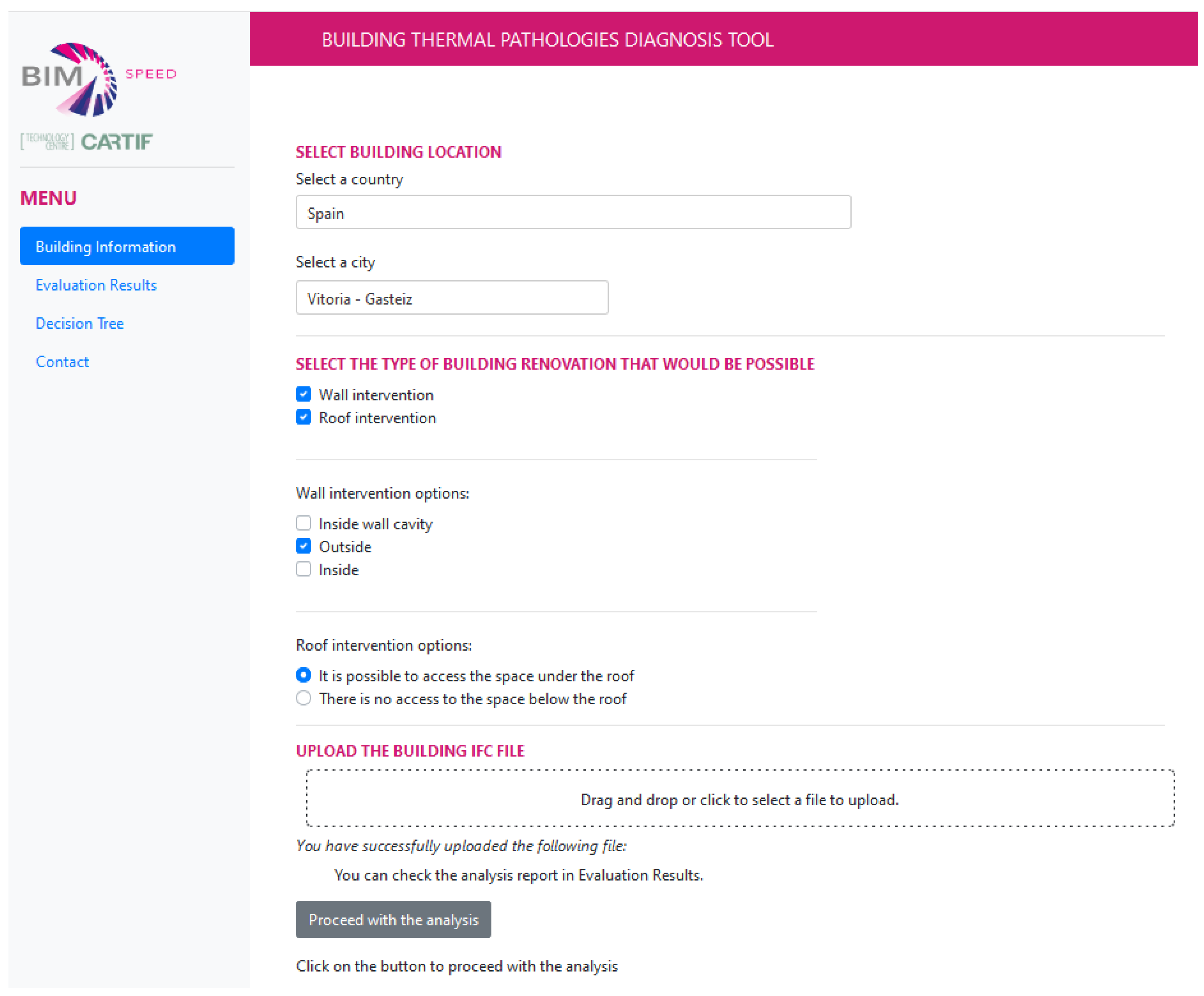
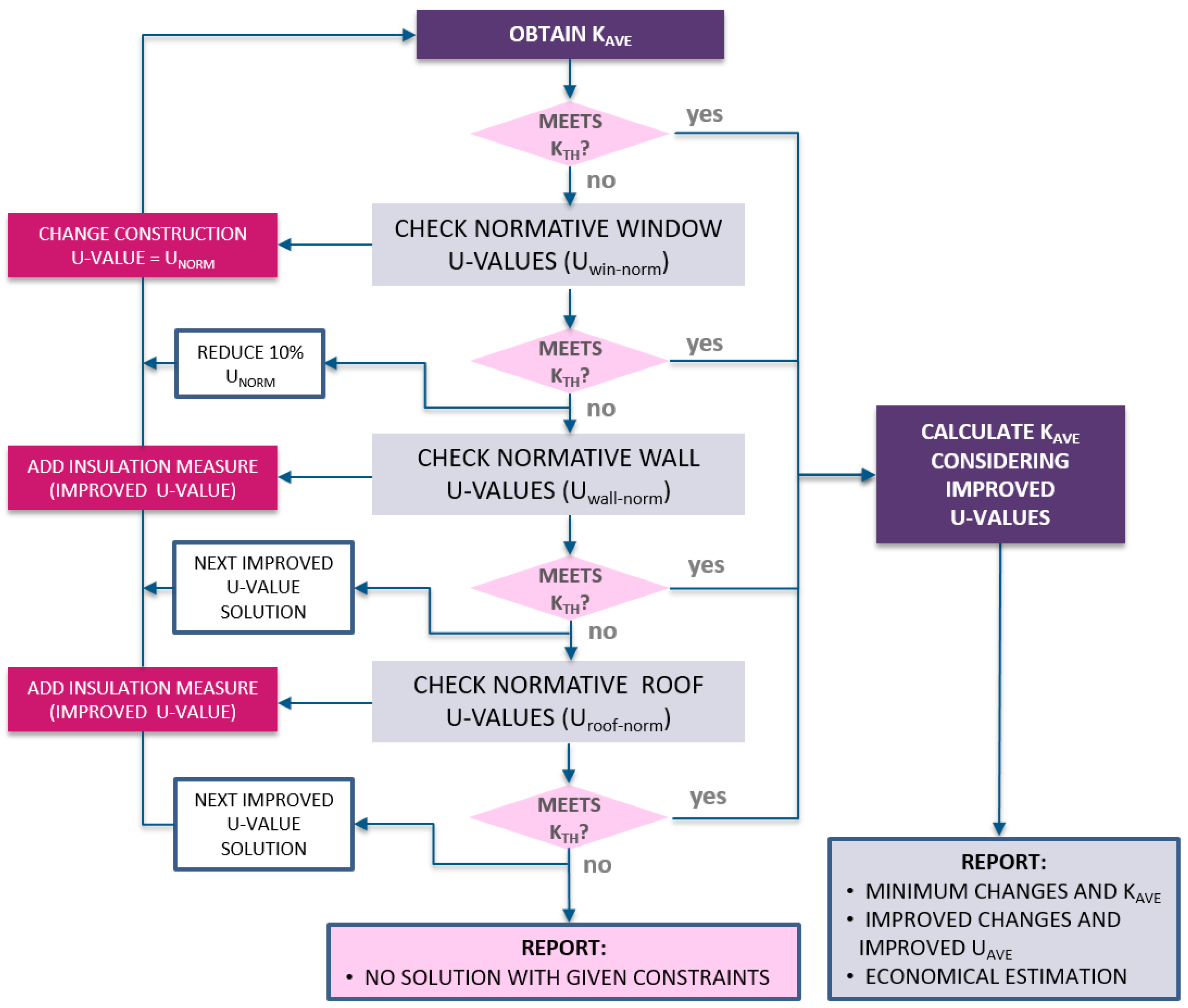
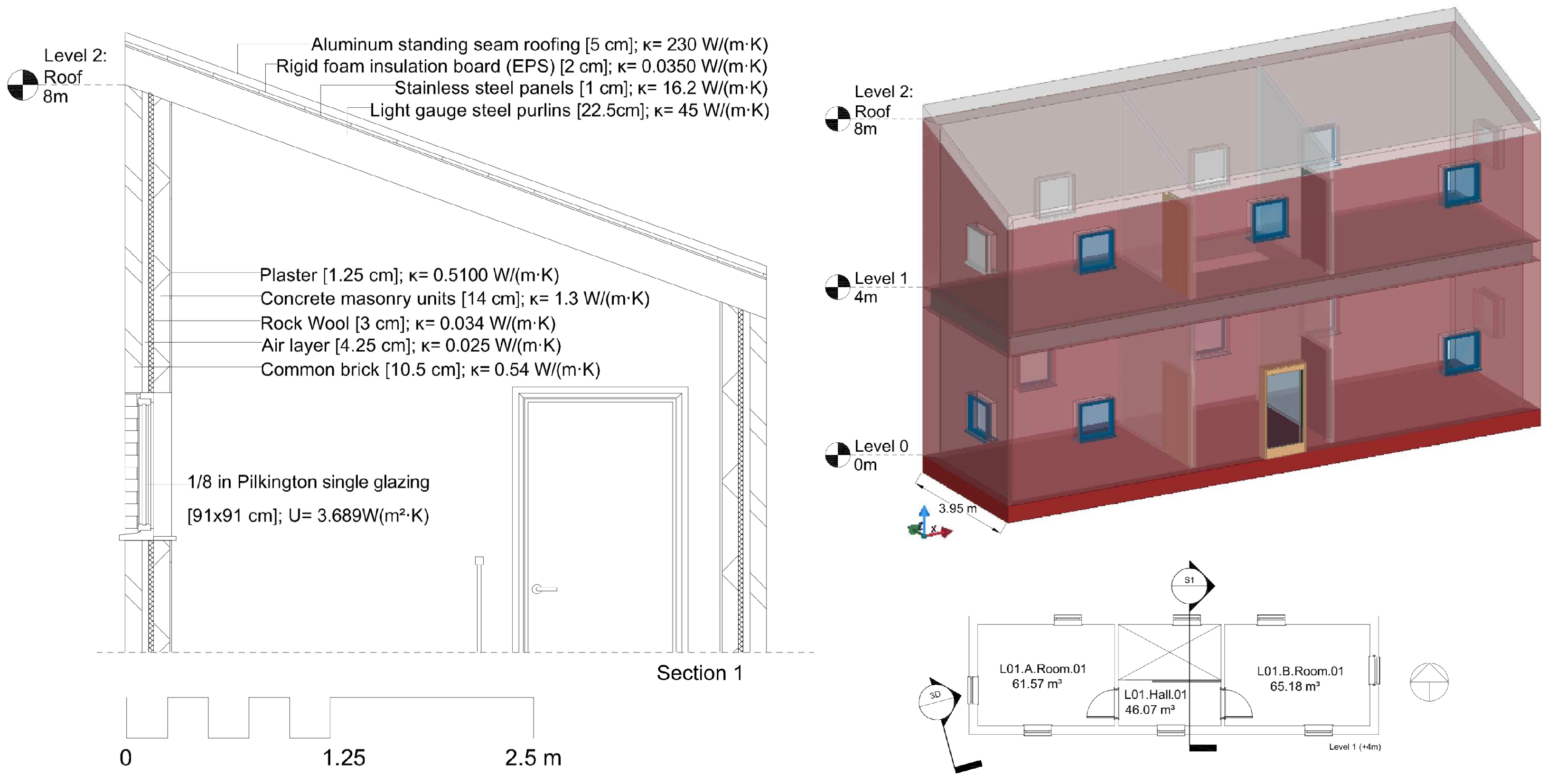
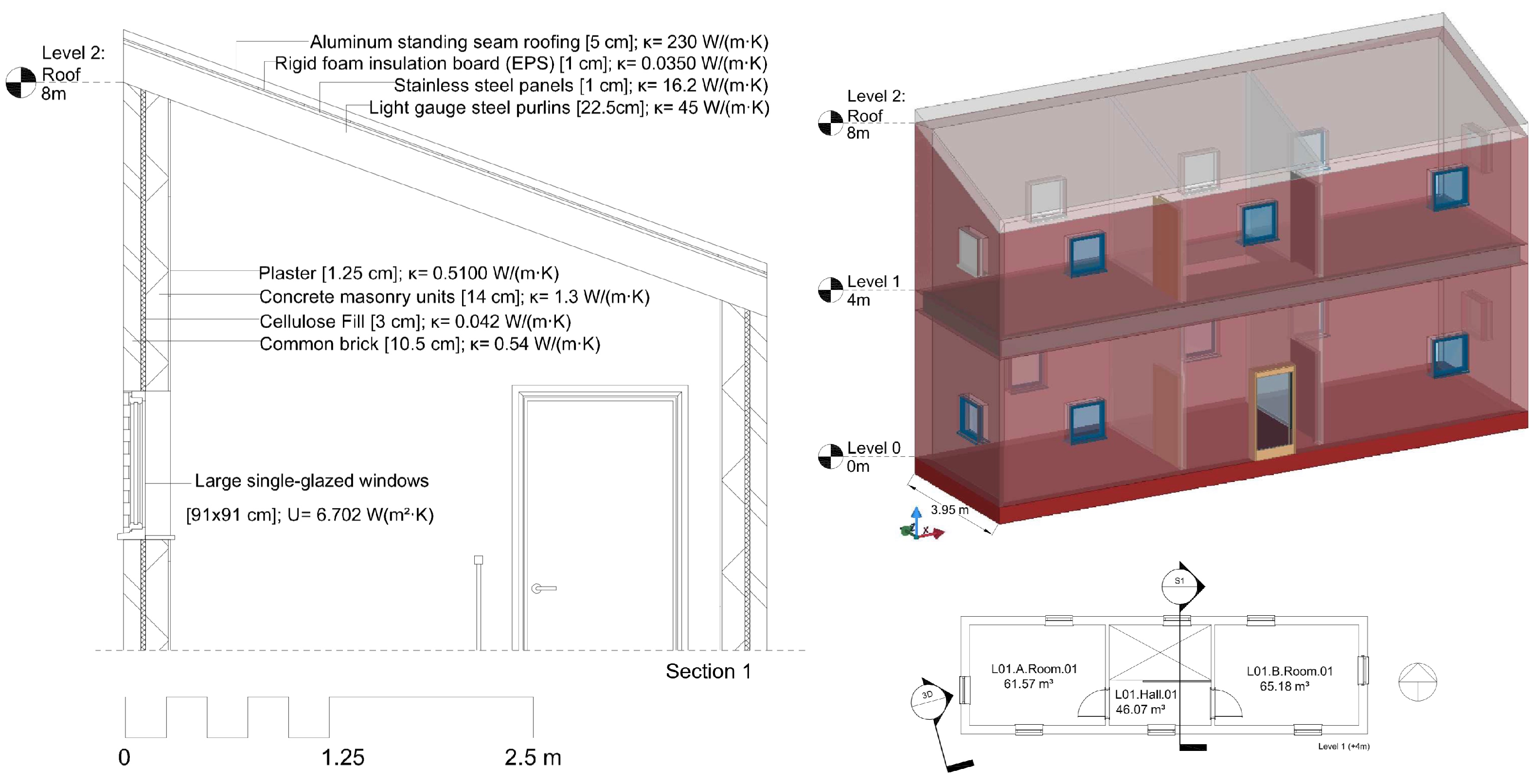
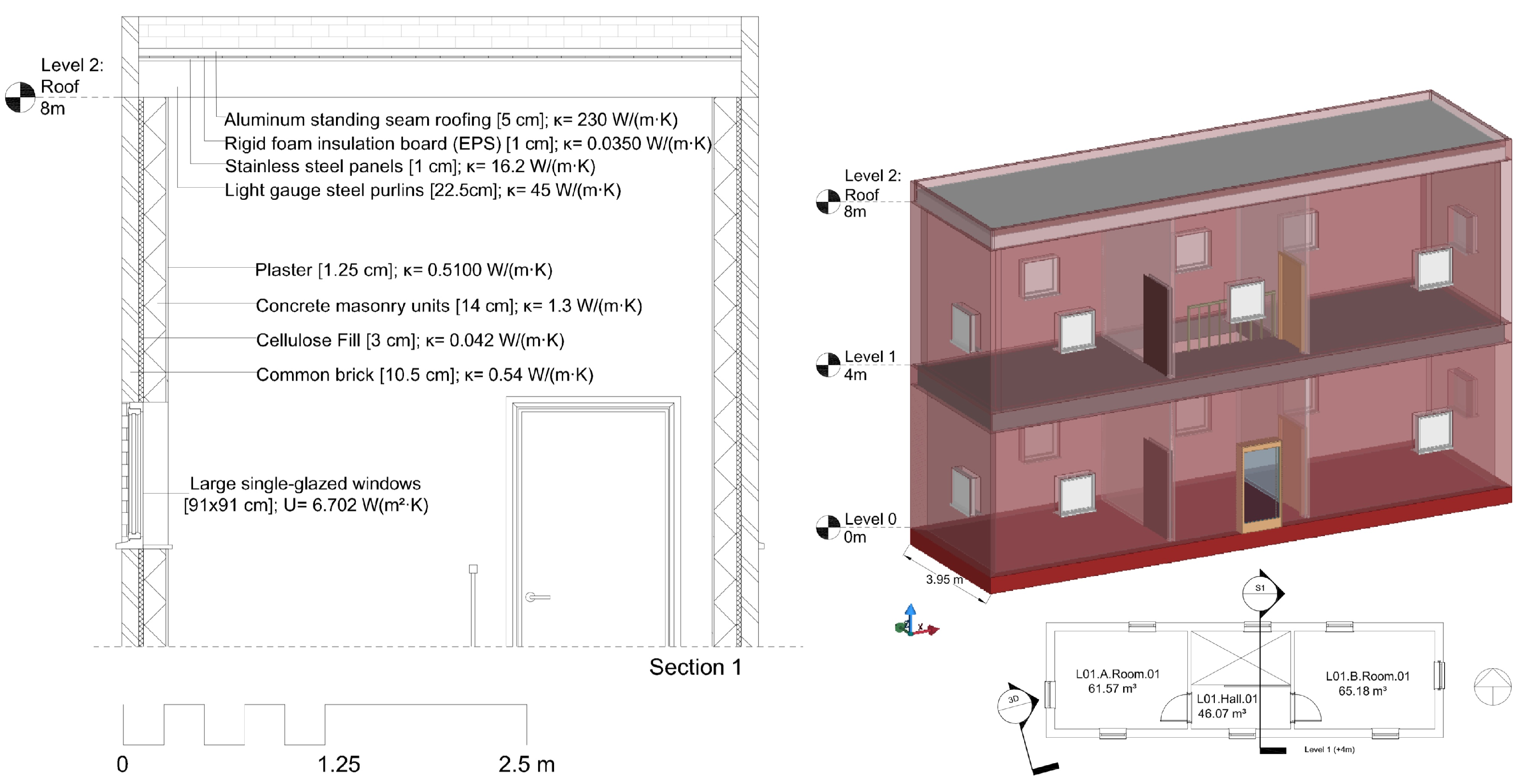
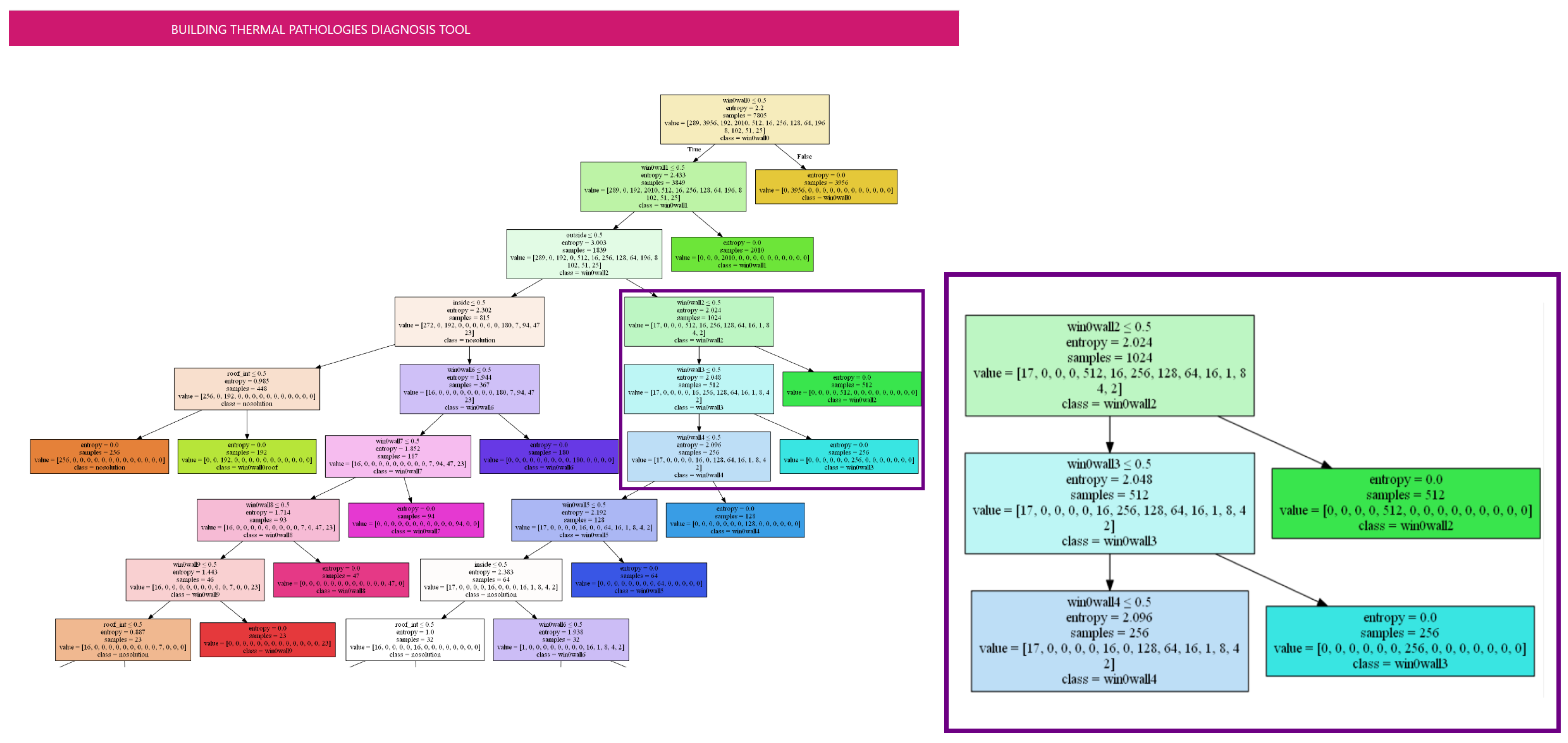

| Multihouse Building/Apartment | ||||
|---|---|---|---|---|
| Year | State | Roof 1 | Roof 2 | Wall |
| –1918 | OR | Titled roof with cavity between rafters | Masonry of natural stones or bricks | |
| Us.R. | Insulate cavity between rafters (heighten rafters and clear interspace if necessary), T.Ins.THK 12 cm | Add 8 cm of ins. on inner surface (air-tight cladding, water pipes must not be conducted in outer wall) | ||
| Ad.R. | Insulate cavity between rafters + ins. layer, T.Ins.THK 30 cm | Add 24 cm of ins. + plaster (ext. insulated render system), alternative: Curtain wall | ||
| 1919–1948 | OR | Tilted roof with wood fiberboard planking | Wooden beam ceiling | Brickwork |
| Us.R. | Insulate cavity between rafters (heighten rafters and clear interspace if necessary), T.Ins.THK 12 cm | Add 12 cm ins. above (+flooring if necessary) | Add 12 cm of ins. + plaster (ext. insulated render system), alternative: Curtain wall (e.g., cellulose between timbers) | |
| Ad.R. | Insulate cavity between rafters + ins. layer, T.Ins.THK 30 cm | Add 30 cm ins. above (+flooring if necessary) | Add 24 cm of ins. + plaster (ext. insulated render system), alternative: Curtain wall | |
| 1949–2001 | OR | Concrete ceiling | Masonry of hollow blocks or honeycomb bricks | |
| Us.R. | Add 12 cm ins. above (+flooring if necessary) | Add 12 cm of ins. + plaster (ext. insulated render system), alternative: Curtain wall (e.g., cellulose between timbers) | ||
| Ad.R. | Add 30 cm ins. above (+flooring if necessary) | Add 24 cm of ins. + plaster (ext. insulated render system), alternative: Curtain wall | ||
| 2002–2009 | OR | Tilted roof with 18 cm ins. | Masonry with 14 cm render ins. system | |
| Us.R. | Insulate cavity between rafters (heighten rafters and clear interspace if necessary), T.Ins.THK 12 cm | Add 12 cm of ins. + plaster (ext. insulated render system), alternative: Curtain wall (e.g., cellulose between timbers) | ||
| Ad.R. | Insulate cavity between rafters + ins. layer, T.Ins.THK 30 cm | 24 cm of external ins. brickwork + plaster (ext. insulated render system) | ||
| 2010–2015 | OR | 18 cm ins. on ceiling + roofing | 12 cm of ext. ins. brickwork + plaster (ext. insulated render system) | |
| Us.R. | 35 cm ins. on ceiling + roofing | 24 cm of ext. ins. brickwork + plaster (ext. insulated render system) | ||
| Ad.R. | 40 cm ins. (WLS 032) on ceiling + roofing | 28 cm of ext. ins. brickwork + plaster (ext. insulated render system) | ||
| Country | Regulation |
|---|---|
| Spain | Basic document HE (Energy Saving)—Technical Building Code (2019) [46] |
| Germany | Energy Saving Ordinance-EnEV (2013) [47] |
| Poland | Implementation of the EPBD in Poland (2016) [48] |
| France | Order related to the energy performance of existing buildings, when they are subject of major renovation work (2008) [49] |
| Compactness | Winter Climate Zone | ||||||
|---|---|---|---|---|---|---|---|
| [m/m] | ∝ | A | B | C | D | E | |
| New buildings and extensions | V/A | 0.67 | 0.60 | 0.58 | 0.53 | 0.48 | 0.43 |
| V/A | 0.86 | 0.80 | 0.77 | 0.72 | 0.67 | 0.62 | |
| Changes of use. | V/A | 1.00 | 0.87 | 0.83 | 0.73 | 0.63 | 0.54 |
| Renovations in which more than 25% of the total area of the final thermal envelope of the building is renovated. | V/A | 1.07 | 0.94 | 0.90 | 0.81 | 0.70 | 0.62 |
| Case | Number of Solutions | Details about Solutions |
|---|---|---|
| Tree ends in Window | Up to 3 + no solution | |
| Tree ends in Wall | Up to 10 + no solution | · 2 for insulation in cavity |
| · 4 for external insulation | ||
| · 4 for internal insulation | ||
| Tree ends in Roof | Up to 2 + no solution | Pitched roof: |
| · 1 for internal insulation | ||
| · 1 for external insulation | ||
| Flat roof: | ||
| · 2 for external insulation |
| ECMs for Spain and France | Insulation (Ins.) | Finishing Layer (FL) | Total Values ECM (Ins. + FL) | ||||||||||
|---|---|---|---|---|---|---|---|---|---|---|---|---|---|
| Level | Category | Type | Thickness Ins. [mm] | Material | U-Value [W/(m2·K)] | Thermal Resistance [(m2·K)/W] | Conductivity [W/(m·K)] | Cost [€/m2] | U-Value [W/(m2·K)] | Cost [€/m2] | Total U-Value [W/(m2·K)] | Total Thickness [mm] | Total Cost ECM [€/m2] |
| Façade | Ins. at the Ext. | ETICS (50 mm cement/mortar plaster + ins.) | 60 | Extruded polystyrene | 0.556 | 1.800 | 0.036 | 10.24 | 1.600 | 20.05 | 0.412 | 65 | 30.29 |
| 60 | Mineral Wool | 0.571 | 1.750 | 0.034 | 19.61 | 1.600 | 20.05 | 0.421 | 65 | 39.66 | |||
| 100 | Expanded Polystyrene | 0.380 | 2.630 | 0.038 | 23.26 | 1.600 | 20.05 | 0.307 | 105 | 43.31 | |||
| 100 | Extruded polystyrene | 0.357 | 2.800 | 0.036 | 14.14 | 1.600 | 20.05 | 0.292 | 105 | 34.19 | |||
| Ins. in the cavity wall | Insufflating thermal ins. inside the existing air chamber | 60 | Polyurethane foam | 0.592 | 1.690 | 0.036 | 7.13 | - | - | 0.592 | 60 | 7.13 | |
| Injection of thermal ins. inside the existing air chamber | 60 | Mineral wool | 0.575 | 1.739 | 0.035 | 11.14 | - | - | 0.575 | 60 | 11.14 | ||
| Int. ins. | Plasterboard finish (ins. + 15 mm Plasterboard) | 60 | Extruded polystyrene | 0.571 | 1.750 | 0.034 | 13.89 | 5.333 | 17.49 | 0.516 | 75 | 31.38 | |
| 60 | Expanded Polystyrene | 0.526 | 1.900 | 0.032 | 8.71 | 5.333 | 17.49 | 0.479 | 75 | 26.20 | |||
| 100 | Extruded polystyrene | 0.357 | 2.800 | 0.036 | 22.32 | 5.333 | 17.49 | 0.335 | 115 | 39.81 | |||
| 100 | Expanded Polystyrene | 0.317 | 3.150 | 0.032 | 11.42 | 5.333 | 17.49 | 0.300 | 115 | 28.91 | |||
| Pitched roof | Ext. ins. | Ins. of cavity between rafters | 100 | Extruded Polystyrene | 0.380 | 2.632 | 0.038 | 24.66 | - | - | 0.380 | 115 | 24.66 |
| Plasterboard finish (Ins. + 15 mm Plasterboard) | 100 | Mineral wool | 0.370 | 2.700 | 0.038 | 21.94 | 5.333 | 17.49 | 0.346 | 115 | 39.43 | ||
| Flat roof | Ext. ins. | 60 mm of ins., geotextil filter and 100 mm gravel | 60 | Extruded Polyestyrene | 0.567 | 1.765 | 0.034 | 13.32 | 0.870 | 44.77 | 0.343 | 160 | 58.09 |
| 100 mm of ins., geotextil filter and 100 mm gravel | 100 | Extruded Polyestyrene | 0.360 | 2.778 | 0.036 | 33.3 | 0.870 | 44.77 | 0.255 | 200 | 78.07 | ||
| ECMs for Germany | Insulation (Ins.) | Finishing Layer (FL) | Total Values ECM (Ins. + FL) | ||||||||||
|---|---|---|---|---|---|---|---|---|---|---|---|---|---|
| Level | Category | Type | Thickness Ins. [mm] | Material | U-Value [W/(m2·K)] | Thermal Resistance [(m2·K)/W] | Conductivity [W/(m·K)] | Cost [€/m2] | U-Value [W/(m2·K)] | Cost [€/m2] | Total U-Value [W/(m2·K)] | Total Thickness [mm] | Total Cost ECM [€/m2] |
| Façade | Ins. at the Ext. | ETICS (50 mm cement/mortar plaster + ins.) | 120 | Expanded polystyrene | 0.317 | 3.158 | 0.038 | 19.61 | 1.600 | 20.05 | 0.264 | 125 | 39.66 |
| 120 | Extruded polystyrene | 0.300 | 3.333 | 0.036 | 10.24 | 1.600 | 20.05 | 0.253 | 125 | 30.29 | |||
| 240 | Expanded Polystyrene | 0.158 | 6.316 | 0.038 | 39.22 | 1.600 | 20.05 | 0.144 | 245 | 59.27 | |||
| 240 | Extruded polystyrene | 0.150 | 6.667 | 0.036 | 20.48 | 1.600 | 20.05 | 0.137 | 245 | 40.53 | |||
| Ins. in the cavity wall | Insufflating thermal ins. inside the existing air chamber | 60 | Polyurethane foam | 0.592 | 1.690 | 0.036 | 7.13 | - | - | 0.592 | 60 | 7.13 | |
| Injection of thermal ins. inside the existing air chamber | 60 | Mineral wool | 0.575 | 1.739 | 0.035 | 11.14 | - | - | 0.575 | 60 | 11.14 | ||
| Int. ins. | Plasterboard finish (ins. + 15 mm Plasterboard) | 60 | Extruded polystyrene | 0.567 | 1.765 | 0.034 | 13.89 | 5.333 | 17.49 | 0.512 | 75 | 31.38 | |
| 60 | Expanded Polystyrene | 0.533 | 1.875 | 0.032 | 8.71 | 5.333 | 17.49 | 0.485 | 75 | 26.20 | |||
| 100 | Extruded polystyrene | 0.360 | 2.778 | 0.036 | 22.32 | 5.333 | 17.49 | 0.337 | 115 | 39.81 | |||
| 100 | Expanded Polystyrene | 0.320 | 3.125 | 0.032 | 11.42 | 5.333 | 17.49 | 0.302 | 115 | 28.91 | |||
| Pitched roof | Ext. ins. | Ins. of cavity between rafters | 180 | Mineral wool | 0.200 | 5.000 | 0.036 | 73.08 | - | - | 0.200 | 180 | 73.08 |
| Int. ins. | Plasterboard finish (Ins. + 15 mm Plasterboard) | 200 | Mineral wool | 0.185 | 5.405 | 0.037 | 41.52 | 5.333 | 17.49 | 0.185 | 215 | 59.01 | |
| Flat roof | Ext. ins. | 120 mm of ins., geotextil filter and 100 mm gravel | 120 | Extruded Polystyrene | 0.283 | 3.529 | 0.034 | 13.32 | 0.870 | 44.77 | 0.214 | 220 | 58.09 |
| 300 mm of ins., geotextil filter and 100 mm gravel | 300 | Extruded Polystyrene | 0.120 | 8.333 | 0.036 | 33.30 | 0.870 | 44.77 | 0.105 | 400 | 78.07 | ||
| ECMs for Poland | Insulation (Ins.) | Finishing Layer (FL) | Total Values ECM (Ins. + FL) | ||||||||||
|---|---|---|---|---|---|---|---|---|---|---|---|---|---|
| Level | Category | Type | Thickness Ins. [mm] | Material | U-Value [W/(m2·K)] | Thermal Resistance [(m2·K)/W] | Conductivity [W/(m·K)] | Cost [€/m2] | U-Value [W/(m2·K)] | Cost [€/m2] | Total U-Value [W/(m2·K)] | Total Thickness [mm] | Total Cost ECM [€/m2] |
| Façade | Ins. at the Ext. | ETICS (50 mm cement/mortar plaster + ins.) | 120 | Expanded polystyrene | 0.317 | 3.158 | 0.038 | 19.61 | 1.600 | 20.05 | 0.264 | 125 | 39.66 |
| 120 | Extruded polystyrene | 0.300 | 3.333 | 0.036 | 10.24 | 1.600 | 20.05 | 0.253 | 125 | 30.29 | |||
| 240 | Expanded Polystyrene | 0.158 | 6.316 | 0.038 | 39.22 | 1.600 | 20.05 | 0.144 | 245 | 59.27 | |||
| 240 | Extruded polystyrene | 0.150 | 6.667 | 0.036 | 20.48 | 1.600 | 20.05 | 0.137 | 245 | 40.53 | |||
| Ins. in the cavity wall | Insufflating thermal ins. inside the existing air chamber | 60 | Polyurethane foam | 0.592 | 1.690 | 0.036 | 7.13 | - | - | 0.592 | 60 | 7.13 | |
| Injection of thermal ins. inside the existing air chamber | 60 | Mineral wool | 0.575 | 1.739 | 0.035 | 11.14 | - | - | 0.575 | 60 | 11.14 | ||
| Int. ins. | Plasterboard finish (ins. + 15 mm Plasterboard) | 60 | Extruded polystyrene | 0.567 | 1.765 | 0.034 | 13.89 | 5.333 | 17.49 | 0.512 | 75 | 31.38 | |
| 60 | Expanded Polystyrene | 0.533 | 1.875 | 0.032 | 8.71 | 5.333 | 17.49 | 0.484 | 75 | 26.20 | |||
| 100 | Extruded polystyrene | 0.360 | 2.778 | 0.036 | 22.32 | 5.333 | 17.49 | 0.337 | 115 | 39.81 | |||
| 100 | Expanded Polystyrene | 0.320 | 3.125 | 0.032 | 11.42 | 5.333 | 17.49 | 0.302 | 115 | 28.91 | |||
| Pitched roof | Ext. ins. | Ins. of cavity between rafters | 180 | Mineral wool | 0.200 | 5.000 | 0.036 | 73.08 | - | - | 0.200 | 180 | 73.08 |
| Int. ins. | Plasterboard finish (Ins. + 15 mm Plasterboard) | 200 | Mineral wool | 0.185 | 5.405 | 0.037 | 41.52 | 5.333 | 17.49 | 0.185 | 215 | 59.01 | |
| Flat roof | Ext. ins. | 120 mm of ins., geotextil filter and 100 mm gravel | 120 | Extruded Polystyrene | 0.283 | 3.529 | 0.034 | 13.32 | 0.870 | 44.77 | 0.214 | 220 | 58.09 |
| 300 mm of ins., geotextil filter and 100 mm gravel | 300 | Extruded Polystyrene | 0.120 | 8.333 | 0.036 | 33.30 | 0.870 | 44.77 | 0.105 | 400 | 78.07 | ||
| [W/(mK)] | [W/(mK)] | [W/(mK)] | [W/(mK)] | Roof Type | Space under Roof |
|---|---|---|---|---|---|
| 0.714 | 3.689 | 0.348 | 1.732 | Pitched | Yes |
| Location (City, Country) | [W/(mK)] | [W/(mK)] | [W/(mK)] | [W/(mK)] | Selected Solution | Cost [€] | |
|---|---|---|---|---|---|---|---|
| Málaga (zone A), Spain | 0.675 | 2.7 | DGW. |  | 5713.89 | ||
| Bilbao (zone C), Spain | 0.651 | 2.1 | DGW. |  | 5900.21 | ||
| León (zone E), Spain | 0.592 | 0.6 | TGW. |  | 6831.82 | ||
| Warsaw, Poland | 0.632 | 1.6 | DGW. |  | 6272.86 | ||
| Massy, France | 0.643 | 1.9 | DGW. |  | 6210.75 | ||
| Berlin, Germany | 0.449 | 1.3 | 0.109 | DGW. + Ins. outside the walls |  | 20,959.30 | |
| [W/(mK)] | [W/(mK)] | [W/(mK)] | [W/(mK)] | Roof Type | Space under Roof |
|---|---|---|---|---|---|
| 1.587 | 6.702 | 0.961 | 3.423 | Pitched | Yes |
| Location (City, Country) | [W/(mK)] | [W/(mK)] | [W/(mK)] | [W/(mK)] | Selected Solution | Cost [€] | |
|---|---|---|---|---|---|---|---|
| Málaga (zone A), Spain | 0.938 | 2.7 | 0.272 | DGW. + Ins. outside the walls |  | 16,400.24 | |
| Bilbao (zone C), Spain | 0.422 | 2.1 | 0.356 | 0.342 | DGW. + Ins. inside the walls + Ins. inside the roof |  | 15,055.57 |
| León (zone E), Spain | 0.41 | 1.8 | 0.356 | 0.342 | DGW. + Ins. inside the walls + Ins. inside the roof |  | 15,366.11 |
| Warsaw, Poland | 0.868 | 1.6 | 0.238 | DGW. + Ins. outside the walls |  | 16,058.60 | |
| Massy, France | 0.414 | 1.9 | 0.356 | 0.342 | DGW. + Ins. inside the walls + Ins. inside the roof |  | 15,366.11 |
| Berlin, Germany | 0.363 | 1.3 | 0.356 | 0.189 | DGW. + Ins. inside the walls + Ins. inside the roof |  | 18,264.02 |
| [W/(mK)] | [W/(mK)] | [W/(mK)] | [W/(mK)] | Roof Type |
|---|---|---|---|---|
| 1.521 | 6.702 | 0.961 | 3.423 | Flat |
| Location (City, Country) | [W/(mK)] | [W/(mK)] | [W/(mK)] | [W/(mK)] | Selected Solution | Cost [€] | |
|---|---|---|---|---|---|---|---|
| Málaga (zone A), Spain | 0.933 | 2.7 | 0.369 | DGW. + Ins. outside the walls |  | 13,598.54 | |
| Bilbao (zone C), Spain | 0.806 | 2.1 | 0.24 | DGW. + Ins. inside the walls |  | 13,425.64 | |
| León (zone E), Spain | 0.432 | 1.8 | 0.356 | 0.486 | DGW. + Ins. inside the walls + Ins. outside the roof |  | 17,294.07 |
| Warsaw, Poland | 0.785 | 1.6 | 0.238 | DGW. + Ins. outside the walls |  | 16,596.57 | |
| Massy, France | 0.798 | 1.9 | 0.24 | DGW. + Ins. inside the walls |  | 13,736.18 | |
| Berlin, Germany | 0.378 | 1.3 | 0.356 | 0.262 | DGW. + Ins. inside the walls + Ins. outside the roof |  | 17,418.29 |
Publisher’s Note: MDPI stays neutral with regard to jurisdictional claims in published maps and institutional affiliations. |
© 2021 by the authors. Licensee MDPI, Basel, Switzerland. This article is an open access article distributed under the terms and conditions of the Creative Commons Attribution (CC BY) license (https://creativecommons.org/licenses/by/4.0/).
Share and Cite
Mulero-Palencia, S.; Álvarez-Díaz, S.; Andrés-Chicote, M. Machine Learning for the Improvement of Deep Renovation Building Projects Using As-Built BIM Models. Sustainability 2021, 13, 6576. https://doi.org/10.3390/su13126576
Mulero-Palencia S, Álvarez-Díaz S, Andrés-Chicote M. Machine Learning for the Improvement of Deep Renovation Building Projects Using As-Built BIM Models. Sustainability. 2021; 13(12):6576. https://doi.org/10.3390/su13126576
Chicago/Turabian StyleMulero-Palencia, Sofía, Sonia Álvarez-Díaz, and Manuel Andrés-Chicote. 2021. "Machine Learning for the Improvement of Deep Renovation Building Projects Using As-Built BIM Models" Sustainability 13, no. 12: 6576. https://doi.org/10.3390/su13126576
APA StyleMulero-Palencia, S., Álvarez-Díaz, S., & Andrés-Chicote, M. (2021). Machine Learning for the Improvement of Deep Renovation Building Projects Using As-Built BIM Models. Sustainability, 13(12), 6576. https://doi.org/10.3390/su13126576






